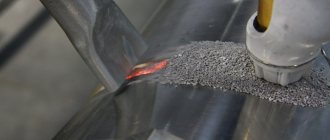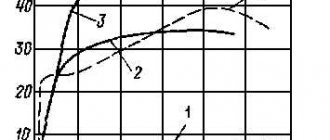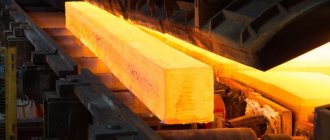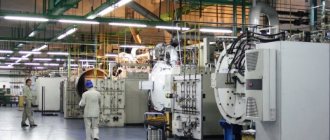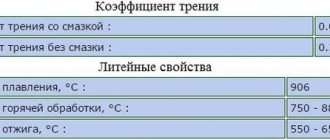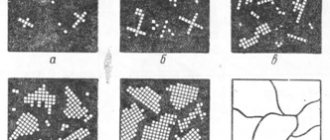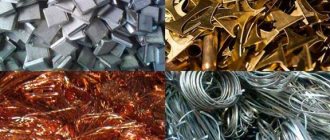Technical translation of the term “casting properties”: English. casting properties, German Giesseigenschaften, fr. properietes de fonderie [1]. Another option for translating the term “foundry properties” into English is founding properties (or foundry properties). Castability is also used - casting qualities, ability to take shape, shaping, from cast - cast.
In general, with regard to terminology, “castability” and “castability” are somewhat different concepts, since the second has a broader meaning, relating to the shaping process as a whole, and the term “castability” refers directly to the characteristics of the material (metal, alloy) .
©ICM (www.modificator.ru)
Casting properties, when we consider metals and alloys, are a collective characteristic that determines the ability of a melt to form a casting with specified technological properties, with minimal economic and time costs, as well as with the minimum possible number of casting defects in the final product. The concept of castability additionally includes geometric parameters of the shape and product.
To one of the most important casting properties of alloys
refers to fluidity (English fluidity, sometimes called castability).
To obtain a high-quality casting, it is necessary to design the optimal shape, manufacture it, select materials with the required casting properties and develop the technology of the entire process, including the obligatory stage of modifying the molten metal.
The development of mold geometry, the quality of molding materials and metal charge, and adherence to technological conditions are, of course, very important. But here we will focus directly on the casting properties of alloys.
As mentioned above, the casting properties of alloys
- this is a set of properties that characterize the ability of molten metal to form high-quality castings.
The concept of casting properties of alloys is expanded by introducing into it, in addition to the “traditional” casting properties of alloys
(shrinkage, segregation, fluidity), such properties as modifiability, tendency to overcooling, the ability to absorb gases when heating the liquid metal and release them when cooling, crack resistance and etc. The casting properties of metals and alloys manifest themselves at the moment of pouring and filling the mold, as well as during the crystallization of the casting.
Fluidity is a casting property of a metal, characterizing its ability to penetrate into all elements of the mold cavity, including those that are difficult to access and thin-walled. Fluidity is influenced by a whole range of factors, ranging from the temperature range of crystallization of a particular casting alloy, surface tension and viscosity of the metal melt, temperature conditions of the process, and ending with the properties of the mold itself (temperature, thermal conductivity, etc.).
During the cooling process of the melt, metals reduce their volume, as a result of which the casting property of metals and alloys, such as shrinkage, manifests itself.
©ICM (www.modificator.ru)
To prevent casting defects that appear due to volumetric shrinkage, profits are designed. Linear shrinkage of the casting alloy is also taken into account when designing the mold and developing the technology.
See also Liquation.
Casting properties of alloys
Casting alloys and their applications
Casting alloys are produced by fusing two or more metals and non-metals . Such alloys must have good fluidity and thermal conductivity , increased ductility, etc. The practical importance of casting alloys is determined by the fact that they in some properties (strength, hardness, ability to reproduce the outlines of casting molds, machinability with cutting tools, etc.) .
Alloys with special physical properties (for example, electrical conductivity, magnetic permeability, etc.) occupy an important place in foundry production
Alloys, depending on their chemical composition, differ from each other in melting point, chemical reactivity, viscosity in the molten state, strength, ductility and other properties . For the production of shaped castings, gray, high-strength, malleable and other cast irons, carbon and alloy steels, alloys of aluminum, magnesium, copper, titanium, etc. are used.
Not all alloys are equally suitable for the manufacture of shaped castings. From some alloys (gray cast iron, silumin) it is possible to easily produce a casting of complex configuration, while from others (titanium alloys, alloy steels, etc.) obtaining castings is associated with certain difficulties. Obtaining high-quality castings without cavities, cracks and other defects depends on the casting properties of the alloys . The main casting properties of alloys include fluidity, shrinkage of alloys, tendency to crack, gas absorption and segregation .
Fluidity —
the ability of molten metal to flow through the channels of a casting mold, fill its cavities and clearly reproduce the contours of the casting.
With high fluidity, casting alloys fill all elements of the casting mold; with low fluidity, the mold cavity is partially filled, and underfills form in narrow sections. The fluidity of alloys is determined using special tests . The length of the filled spiral in the mold is taken as a measure of fluidity, and it depends on many factors. For example, increasing the pouring temperature increases the fluidity of all alloys. The higher the thermal conductivity of the mold material, the faster the heat is removed from the poured metal , the lower the fluidity .
Non-metallic inclusions reduce the fluidity of alloys. The fluidity is affected by the chemical composition of the alloys : with an increase in the content of sulfur, oxygen and chromium in the source material, fluidity decreases, and with an increase in the content of phosphorus, silicon, aluminum, and carbon, it increases.
Depending on the fluidity , the minimum wall thickness of the castings is selected . For example, when making small castings from gray cast iron in sand molds, the minimum wall thickness is 3-4 mm, for medium ones - 8-10 mm, for large ones - 12-15 mm; for steel castings, respectively, 5-7, 10-12, 15-20 mm.
Shrinkage —
the process of reducing the volume of a casting by cooling, starting from a certain temperature of the liquid metal in the mold to ambient temperature.
Shrinkage occurs in the liquid state , during solidification during crystallization, and in the solid state. There are linear and volumetric shrinkage , which are determined as a percentage. The amount of shrinkage of alloys depends on their chemical composition , pouring temperature, casting configuration and other factors. Gray cast iron (0.9-1.3%) and aluminum alloys - silumin (0.9-1.3%) have the smallest linear shrinkage. Steels and some non-ferrous alloys have shrinkage of 1.8 to 2.5%. It is difficult to produce castings from alloys with increased shrinkage , since shrinkage cavities and shrinkage porosity are formed in the massive parts of the casting .
To prevent the formation of shrinkage cavities, it is necessary to install profits - additional reservoirs with molten metal to feed the castings during their solidification. Stresses in castings arise due to their uneven cooling and mechanical inhibition of shrinkage. They are typical for castings with different wall thicknesses . During solidification, the temperature of the casting in massive parts is higher than on the outside or in thin sections. Therefore, shrinkage in individual places varies in magnitude , but since parts of the same casting cannot change their sizes independently of each other, stresses arise in it, which can cause cracking or warping. To prevent the formation of large stresses and cracks, it is necessary in the design of the cast part to provide for uniform wall thickness , smooth transitions and eliminate elements that impede the shrinkage of the alloy, as well as use casting molds and cores of increased compliance. Cracks quite often form in castings made of carbon and alloy steels, magnesium alloys and many aluminum alloys (for more information on defects, see Section 5).
Gas absorption—
the ability of cast alloys
in the molten state to dissolve hydrogen, nitrogen, oxygen and other gases . The degree of solubility of gases depends on the state of the alloy: with increasing temperature of the hard alloy it increases slightly , increases slightly during melting and increases sharply when the melt overheats . During solidification and subsequent cooling, the solubility of gases decreases , and as a result of their release, gas pockets and pores can form .
The solubility of gases depends on the chemical composition of the alloy , the pouring temperature, the viscosity of the alloy and the properties of the casting mold. To reduce the gas saturation of alloys, melting in a vacuum or in an environment of inert gases and other methods are used
Segregation —
heterogeneity of the chemical composition in different parts of the casting. There are zonal and dendritic (intragranular) liquations.
Zonal segregation is in the volume of the entire solidified cast part. Dendritic chemical heterogeneity - segregation - chemical heterogeneity within one grain (dendrite) of an alloy. Liquation depends on the chemical composition of the alloy, casting configuration, cooling rate and other factors .
Casting alloys and their applications
Casting alloys are produced by fusing two or more metals and non-metals . Such alloys must have good fluidity and thermal conductivity , increased ductility, etc. The practical importance of casting alloys is determined by the fact that they in some properties (strength, hardness, ability to reproduce the outlines of casting molds, machinability with cutting tools, etc.) .
Alloys with special physical properties (for example, electrical conductivity, magnetic permeability, etc.) occupy an important place in foundry production
Alloys, depending on their chemical composition, differ from each other in melting point, chemical reactivity, viscosity in the molten state, strength, ductility and other properties . For the production of shaped castings, gray, high-strength, malleable and other cast irons, carbon and alloy steels, alloys of aluminum, magnesium, copper, titanium, etc. are used.
Not all alloys are equally suitable for the manufacture of shaped castings. From some alloys (gray cast iron, silumin) it is possible to easily produce a casting of complex configuration, while from others (titanium alloys, alloy steels, etc.) obtaining castings is associated with certain difficulties. Obtaining high-quality castings without cavities, cracks and other defects depends on the casting properties of the alloys . The main casting properties of alloys include fluidity, shrinkage of alloys, tendency to crack, gas absorption and segregation .
Fluidity —
the ability of molten metal to flow through the channels of a casting mold, fill its cavities and clearly reproduce the contours of the casting.
With high fluidity, casting alloys fill all elements of the casting mold; with low fluidity, the mold cavity is partially filled, and underfills form in narrow sections. The fluidity of alloys is determined using special tests . The length of the filled spiral in the mold is taken as a measure of fluidity, and it depends on many factors. For example, increasing the pouring temperature increases the fluidity of all alloys. The higher the thermal conductivity of the mold material, the faster the heat is removed from the poured metal , the lower the fluidity .
Non-metallic inclusions reduce the fluidity of alloys. The fluidity is affected by the chemical composition of the alloys : with an increase in the content of sulfur, oxygen and chromium in the source material, fluidity decreases, and with an increase in the content of phosphorus, silicon, aluminum, and carbon, it increases.
Depending on the fluidity , the minimum wall thickness of the castings is selected . For example, when making small castings from gray cast iron in sand molds, the minimum wall thickness is 3-4 mm, for medium ones - 8-10 mm, for large ones - 12-15 mm; for steel castings, respectively, 5-7, 10-12, 15-20 mm.
Shrinkage —
the process of reducing the volume of a casting by cooling, starting from a certain temperature of the liquid metal in the mold to ambient temperature.
Shrinkage occurs in the liquid state , during solidification during crystallization, and in the solid state. There are linear and volumetric shrinkage , which are determined as a percentage. The amount of shrinkage of alloys depends on their chemical composition , pouring temperature, casting configuration and other factors. Gray cast iron (0.9-1.3%) and aluminum alloys - silumin (0.9-1.3%) have the smallest linear shrinkage. Steels and some non-ferrous alloys have shrinkage of 1.8 to 2.5%. It is difficult to produce castings from alloys with increased shrinkage , since shrinkage cavities and shrinkage porosity are formed in the massive parts of the casting .
To prevent the formation of shrinkage cavities, it is necessary to install profits - additional reservoirs with molten metal to feed the castings during their solidification. Stresses in castings arise due to their uneven cooling and mechanical inhibition of shrinkage. They are typical for castings with different wall thicknesses . During solidification, the temperature of the casting in massive parts is higher than on the outside or in thin sections. Therefore, shrinkage in individual places varies in magnitude , but since parts of the same casting cannot change their sizes independently of each other, stresses arise in it, which can cause cracking or warping. To prevent the formation of large stresses and cracks, it is necessary in the design of the cast part to provide for uniform wall thickness , smooth transitions and eliminate elements that impede the shrinkage of the alloy, as well as use casting molds and cores of increased compliance. Cracks quite often form in castings made of carbon and alloy steels, magnesium alloys and many aluminum alloys (for more information on defects, see Section 5).
Gas absorption—
the ability of cast alloys
in the molten state to dissolve hydrogen, nitrogen, oxygen and other gases . The degree of solubility of gases depends on the state of the alloy: with increasing temperature of the hard alloy it increases slightly , increases slightly during melting and increases sharply when the melt overheats . During solidification and subsequent cooling, the solubility of gases decreases , and as a result of their release, gas pockets and pores can form .
The solubility of gases depends on the chemical composition of the alloy , the pouring temperature, the viscosity of the alloy and the properties of the casting mold. To reduce the gas saturation of alloys, melting in a vacuum or in an environment of inert gases and other methods are used
Segregation —
heterogeneity of the chemical composition in different parts of the casting. There are zonal and dendritic (intragranular) liquations.
Zonal segregation is in the volume of the entire solidified cast part. Dendritic chemical heterogeneity - segregation - chemical heterogeneity within one grain (dendrite) of an alloy. Liquation depends on the chemical composition of the alloy, casting configuration, cooling rate and other factors .
mtomd.info
Main casting alloys
1. Cast iron (see all posts tagged cast iron) is the most common material for producing shaped castings.
Iron castings account for about 80% of all castings. Cast iron has become widespread due to its good technological properties and relative cheapness. The cheapest castings are made from gray cast iron (1.5 times cheaper than steel, several times cheaper than non-ferrous metals). The scope of application of cast iron is expanding due to the continuous improvement of its strength and technological characteristics. Gray, high-strength, malleable and alloy cast irons are used.
2. Steel (see all entries tagged steel and alloys) as a casting material is used to produce castings of parts, which, along with high strength, must have good plastic properties. The more important the machine, the greater the proportion of steel castings used for its production. Steel casting makes up: in diesel locomotives – 40...50% of the vehicle’s weight; in energy and heavy engineering (hydraulic turbine wheels weighing 85 tons, sometimes several hundred tons) - up to 60%. Steel castings after appropriate heat treatment are not inferior in mechanical properties to forgings.
Used: carbon steels 15L...55L; alloy steels 25GSL, 30KhGSL, 110G13L; stainless steels 10Х13Л, 12Х18Н9ТЛ, etc.
Among the casting materials made from non-ferrous metal alloys, copper and aluminum alloys are widely used:
1. Copper alloys - bronze and brass.
Brasses are the most common copper alloys. For the manufacture of various equipment for marine shipbuilding, operating at a temperature of 300 ° C, bearing bushings and cages, pressure screws and nuts of rolling mills, and worm screws, complex alloyed brass is used. They have good wear resistance, anti-friction properties, and corrosion resistance.
Tin bronzes (BrO3Ts7S5N1) are used to make fittings, gears, bearings, and bushings.
Tin-free bronzes are superior to tin bronzes in some properties. They have higher mechanical properties, anti-friction properties, and corrosion resistance. However, their casting properties are worse. Used for the manufacture of propellers of large ships, heavily loaded gears and gears, pump housings, parts of the chemical and food industries.
2. Aluminum alloys. Aluminum alloy castings account for about 70% of non-ferrous castings. They have high specific strength, high casting properties, and corrosion resistance in atmospheric conditions.
The alloys of the aluminum - silicon (Al-Si) system - silumins AL2, AL9 have the highest casting properties. They are widely used in mechanical engineering, the automotive and aviation industries, and the electrical industry (see Electrical engineering).
Alloy systems are also used: aluminum - copper, aluminum - copper - silicon, aluminum - magnesium.
3. Magnesium alloys have high mechanical properties, but their casting properties are low. Alloys of the magnesium-aluminum-zinc-manganese system are used in instrument making, the aviation industry, and textile engineering.
Casting properties of alloys
Obtaining high-quality castings without cavities, cracks and other defects depends on the casting properties of the alloys, which manifest themselves during the filling of the mold, crystallization and cooling of the castings in the mold. The main casting properties of alloys include: fluidity, shrinkage of alloys, tendency to crack, gas absorption, segregation.
Fluidity is the ability of molten metal to flow through the channels of a casting mold, fill its cavities and clearly reproduce the contours of the casting. With high fluidity, the alloys fill all elements of the casting mold. Fluidity depends on many factors: the temperature range of crystallization, viscosity and surface tension of the melt, pouring and mold temperatures, mold properties, etc.
Pure metals and alloys that solidify at a constant temperature have better fluidity than alloys that solidify in a temperature range (solid solutions). The higher the viscosity, the less fluidity. As surface tension increases, fluidity decreases. With increasing temperature of pouring molten metal and mold, fluidity improves. Increasing the thermal conductivity of the mold material reduces fluidity. Thus, a sand mold removes heat more slowly, and the molten metal fills it better than a metal mold. The presence of non-metallic inclusions reduces fluidity. The chemical composition of the alloy also affects (with an increase in the content of sulfur, oxygen, chromium, fluidity decreases; with an increase in the content of phosphorus, silicon, aluminum, carbon, fluidity increases).
Shrinkage is the property of metals and alloys to reduce volume when cooled in the molten state, during solidification, and in the solidified state when cooled to ambient temperature. The change in volume depends on the chemical composition of the alloy, pouring temperature, and casting configuration. There are volumetric and linear shrinkage.
As a result of volumetric shrinkage, shrinkage cavities and shrinkage porosity appear in massive parts of the casting. To prevent the formation of shrinkage cavities, additional tanks with molten metal are installed, as well as external or internal refrigerators.
Linear shrinkage determines the dimensional accuracy of the resulting castings, so it is taken into account when developing casting technology and making pattern equipment. Linear shrinkage is: for gray cast iron - 0.8...1.3%; for carbon steels – 2…2.4%; for aluminum alloys – 0.9…1.45%; for copper alloys – 1.4…2.3%.
Gas absorption is the ability of casting alloys in the molten state to dissolve hydrogen, nitrogen, oxygen and other gases. The degree of solubility of gases depends on the state of the alloy: with increasing temperature of the hard alloy it increases slightly; increases upon melting; increases sharply when the melt overheats. During solidification and subsequent cooling, the solubility of gases decreases; as a result of their release, gas pockets and pores can form in the casting.
The solubility of gases depends on the chemical composition of the alloy, the pouring temperature, the viscosity of the alloy and the properties of the casting mold.
Liquation is the heterogeneity of the chemical composition of the alloy in different parts of the casting. Liquation is formed during the solidification of the casting, due to the different solubility of the individual components of the alloy in its solid and liquid phases. In steels and cast irons, sulfur, phosphorus and carbon are noticeably eliminated.
A distinction is made between zonal segregation, when different parts of the casting have different chemical compositions, and dendritic segregation, when chemical heterogeneity is observed in each grain.
Digital library
General technical disciplines / Production technology / Casting properties of alloys
Not all alloys are equally suitable for the manufacture of shaped castings. From some alloys it is possible to easily produce a casting of a complex configuration, while from others, obtaining castings is associated with certain difficulties. Obtaining high-quality castings without cavities, cracks and other defects depends on the casting properties of the alloys. The main casting properties of alloys include: fluidity, shrinkage of alloys, tendency to crack, gas absorption and segregation.
Fluidity
is
the ability of molten metal to flow through the channels of a casting mold, fill its cavities and clearly reproduce the contours of the casting. With high fluidity, casting alloys fill all elements of the casting mold; with low fluidity, the mold cavity is partially filled, and underfills form in narrow sections. The fluidity of alloys is determined by special samples (spiral or rod), cast in various forms. Fluidity is assessed by the length of the resulting spiral or rod in millimeters.
The fluidity of alloys depends on many factors: for example, increasing the pouring temperature increases the fluidity of all alloys. The higher the thermal conductivity of the mold material, the faster the heat is removed from the poured metal, the lower the fluidity. Non-metallic inclusions reduce the fluidity of alloys. The fluidity is affected by the chemical composition of the alloys: with an increase in the content of sulfur, oxygen and chromium in the source material, the fluidity decreases, and with an increase in the content of phosphorus, silicon, aluminum and carbon, it increases. Depending on the fluidity of the alloy, the minimum wall thickness of the castings is selected.
Shrinkage
is
the property of metals and alloys to reduce their volume when cooled in the molten state, during solidification, and in the solidified state when cooled to ambient temperature. The change in casting volume depends on the chemical composition of the alloy, pouring temperature, casting configuration and other factors. There are volumetric and linear shrinkage, expressed as a percentage.
As a result of volumetric shrinkage, shrinkage cavities and shrinkage porosity appear in massive parts of the casting.
To prevent the formation of shrinkage cavities, profits are installed - additional reserves with molten metal and refrigerators.
Linear shrinkage determines the dimensional accuracy of the resulting castings, so it is taken into account when designing the casting process and manufacturing pattern equipment. Each alloy has its own specific linear shrinkage
Gas absorption
–
the ability of cast alloys in the molten state to dissolve hydrogen, nitrogen, oxygen and other gases.
The degree of solubility of gases depends on the state of the alloy: with increasing temperature of the solid alloy, it increases slightly, increases slightly during melting, and increases sharply when the melt is overheated. During solidification and subsequent cooling, the solubility of gases decreases, and as a result of their release, gas pockets and pores can form in the casting. The solubility of gases depends on the chemical composition of the alloy, the pouring temperature, the viscosity of the alloy and the properties of the casting mold.
Liquation
is
the heterogeneity of the chemical composition in different parts of the casting. There are zonal and dendritic liquation. Zonal segregation is a chemical heterogeneity in the volume of the entire solidified part. Dendritic segregation is a chemical heterogeneity within one grain (dendrite) of an alloy. Liquation depends on the chemical composition of the alloy, casting configuration, cooling rate and other factors.
The design of the cast part must provide a high level of mechanical and service characteristics for a given mass, configuration, dimensional deviation and surface roughness parameters. When developing the design of a cast part, the designer must take into account the casting properties of the alloys, the technology for manufacturing castings and methods for their further processing.
The wall thickness of the cast part is selected based on the conditions for ensuring sufficient strength, rigidity and other performance properties, as well as the dimensions of the part. To ensure conditions for uniform solidification of the casting, the thickness of the internal walls and ribs is taken to be 10–20% less than the thickness of the outer walls.
The external contours of the casting should be a combination of simple geometric bodies with a predominance of flat, rectilinear surfaces, articulated by smooth transitions.
Basic concepts about casting alloys and their applications | 05/01/2012
Basic concepts about casting alloys and their application Casting alloys are alloys that have special properties that make it possible to successfully produce various castings of complex configurations from them. As a rule, pure metals have worse casting properties than alloys. Therefore, metals are relatively rarely used for the production of castings. According to the requirements of state standards and technical specifications, there are about 600 casting alloys used for the manufacture of castings. In addition, modern technologies make it possible to successfully use even non-cast alloys for casting. Basic concepts about alloys A distinction should be made between pure metals and alloys. Metal is a chemical element characterized by a complex of so-called metallic properties: high electrical and thermal conductivity, metallic luster, high plastic properties, positive temperature coefficient of resistance. Often, industrial metals used in foundries contain a significant amount of impurity elements. Alloy is a metal-based substance that is formed by the fusion of two or more elements. In this case, metals can also be alloyed with non-metals, for example, cast iron - an alloy of iron and carbon. All alloys, depending on their ability to plastic deformation, are divided into deformable and non-deformable. The composition of the alloy should include the base, impurities and alloying components. The basis - this is, as a rule, one metal that determines the service properties of the alloy. Impurities - these are chemical elements that accidentally enter the alloy during its smelting or casting. Sources of impurities can be: primary ore raw materials, atmosphere, additives, fuel, molding sands, etc. As a rule, the content of impurities is insignificant, but it has an effect (usually negative) on the service properties of the alloy. Alloying - these are elements that are specially added to the alloy to give it special properties. Sometimes such additives are introduced in very small quantities (hundredths of a percent or less) - this process is called microalloying. In the case when elements are introduced into an alloy in order to change the grain structure or the shape of non-metallic inclusions, such additives are called modifiers. Requirements for the properties of casting alloys Casting alloys in the liquid state must fill the cavities of the casting mold well and, after solidification, provide the required mechanical, physical and chemical properties, as well as the exact dimensions and density of the castings with the least scrap and low cost. It is especially important that the alloy has a low melting point. The lower the melting point of the alloy, the easier it is to melt it and then heat it to the temperature required for pouring. Besides, casting alloys must have the following properties:- high fluidity in the molten state, ensuring good filling of the cavities of the casting mold (especially in the manufacture of thin-walled complex castings);
- slight shrinkage during solidification and cooling, which reduces the formation of cavities and shrinkage leaks in castings, and also weakens internal casting stresses in castings;
- insignificant ability in the liquid state to absorb gases, which reduce the risk of formation of gas pockets during solidification, and contributes to obtaining higher properties of castings after cooling;
- crystal structure (structure), which provides the necessary properties of castings after solidification and cooling;
- slight segregation (heterogeneity in chemical composition), weakening the difference in the properties of individual parts of the castings;
- lowest cost, i.e. be made from the cheapest and most abundant materials;
- easy to machine and have the ability to weld.
Basics of choosing a foundry alloy for castings Casting alloys used in industry satisfy the set conditions only partially, and therefore in each specific case they strive to use the alloy that is most suitable in this particular case. Thus, if cast parts are not subject to high demands in terms of mechanical properties, then usually such parts are made from the cheapest casting alloy - cast iron (Figure 1), which has a relatively low melting point, good fluidity, low shrinkage and other positive properties. But if parts must have high mechanical properties, then they must be made of steel, although it is more expensive than cast iron and has a high melting point, poorer fluidity and greater shrinkage.
Figure 1 - Iron Castings Sometimes the environment in which the parts must operate is critical. For example, for work in sea water they are made from more expensive copper (Figure 2) alloys (bronze or brass), since cast iron and ordinary steel are easily destroyed in such an environment due to insufficient chemical resistance.
Figure 2 - Brass casting In some cases, for example, in the manufacture of castings for aircraft construction, when weight is critical, aluminum alloys (or magnesium) are used, despite the fact that they are inferior in properties to other alloys, and often more expensive than them (Figure 3 ).
Figure 3 - Aluminum casting Thus, when choosing a casting alloy, the designer, together with the foundryman, first of all takes into account the operating conditions of the cast parts and the requirements for them, and then selects an alloy that meets the requirements and at the same time has the best possible casting properties, good machinability, contains a small amount of scarce metals and has a min. price.
Casting alloys
CASTING
Casting is a technological process of producing blanks or parts as a result of free or forced pouring of molten metal into the cavity of a casting mold, which corresponds to the configuration of the resulting product (casting) .
The weight of castings ranges from a few grams to 350 tons.
Castings are made from cast iron, steel, non-ferrous and refractory metals and alloys.
Cast iron castings make up about 80% of all castings. The cheapest castings are made from gray cast iron (1.5 times cheaper than steel, several times cheaper than non-ferrous metals).
Steel, as a casting material, is used to produce castings of parts, which, along with high strength, must have good plastic properties. The more important the machine, the greater the proportion of steel castings used for its production.
Castings from non-ferrous and refractory metals and alloys are used for the manufacture of parts with special properties (wear resistance, anti-friction properties, corrosion resistance). At the same time, castings from aluminum alloys make up about 70% of non-ferrous castings.
The main properties of casting alloys include fluidity, shrinkage, gas absorption, segregation, and tendency to crack.
Fluidity is the ability of metal in a molten state to fill the cavity of a casting mold, accurately reproducing its outline.
Fluidity depends on:
1- on the temperature of the metal being poured (the higher the temperature, the better the fluidity)
2- depending on the temperature of the mold (the higher the temperature, the better the fluidity)
3- from the material of the casting mold (if the material of the casting mold has high thermal conductivity and heat transfer, the mold is heated to a temperature of 50-300 ° C to increase fluidity)
4 - on the structure of the metal (solid solutions have low fluidity, mechanical mixtures have high fluidity)
5 - on the chemical composition of the alloy (with an increase in the content of non-metallic inclusions, sulfur, oxygen and chromium, fluidity decreases, and with an increase in the content of phosphorus, silicon, carbon and aluminum, on the contrary, it increases);
6 - from the crystallization interval (the narrower the crystallization interval, the higher the fluidity)
Fluidity is determined by a special technological test called a spiral (Fig. 1L)
| Rice. 1L Technological sample (spiral) |
| 1- spiral; 2- upper platform; 3- lower half-mold Spiral 1 is formed in a casting mold, consisting of upper 2 and lower 3 mold halves (Fig. 1L, b) after pouring molten metal into it. Fluidity is assessed by the value l (Fig. 1L,a). The larger l, the better the fluidity. With low fluidity, defects such as underfilling and soldering may occur in the casting. |
Shrinkage is the property of metals and alloys to decrease in volume when cooled in the molten state, during solidification, and in the solidified state when cooled to ambient temperature (20°C). Shrinkage is divided into volumetric and linear.
Volumetric shrinkage
(ε
v ) – reduction in the volume of the alloy when it is cooled from the pouring temperature to the ambient temperature.
The change in volume depends on the chemical composition of the alloy, pouring temperature, and casting configuration. Linear shrinkage
(ε
l ) – reduction in the linear dimensions of the casting when it is cooled to ambient temperature.
Linear shrinkage is: for gray cast iron - 0.8...1.3%; for carbon steels - 2...2.4%; for aluminum alloys - 0.9...1.45%; for copper alloys - 1.4...2.3%. ε v ≈ 3 ε v
As a result of shrinkage, defects such as concentrated shrinkage voids, shrinkage porosity, hot and cold cracks, and warping can form.
Gas absorption is the ability of casting alloys in the molten state to dissolve hydrogen, nitrogen, oxygen and other gases. Gas absorption can lead to the appearance of defects such as gas holes and porosity.
Liquation is the heterogeneity of the chemical composition of the cast material in different parts of the casting. Liquation is formed during the solidification of the casting, due to the different solubility of the individual components of the alloy in its solid and liquid phases. In steels and cast irons, sulfur, phosphorus and carbon are noticeably eliminated. There are dendritic and zonal segregation (see the structure of a steel ingot). Segregation causes heterogeneity in the mechanical properties in different parts of the casting.
Tendency to form cracks - defects in the form of tears of shrinkage origin. The tendency to form cracks increases in the presence of gases (hydrogen, nitrogen, oxygen), impurities (sulfur, phosphorus) and non-metallic inclusions (FeO, MnO, Al2O3, SiO2) in the melt, as well as when the metal is overheated before pouring.
